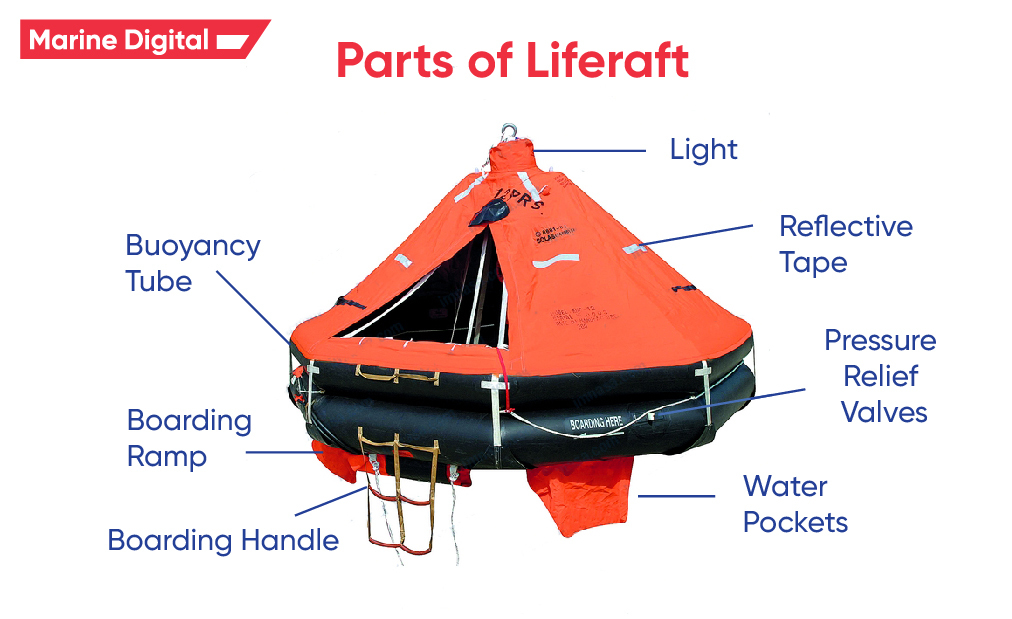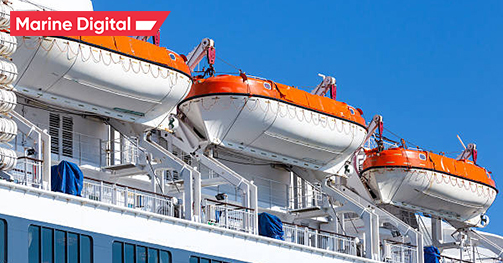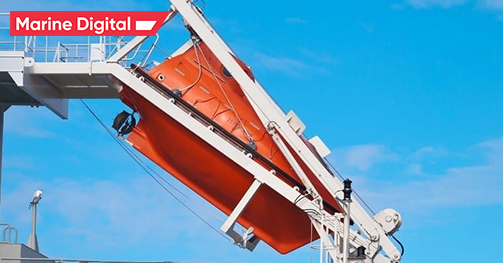What lifeboats can we see today
Every ship must have means of mobilization to ensure that the maximum possible number of passengers and crew on board gets evacuated in case of such mishaps.
Every vessel is equipped with one or more lifeboats that are mounted on board with a common purpose: serving as a means of escape and temporary survival in the occasion of any accident or damage to the vessel. This accident or damage refers to any unfortunate event that risks the vessel eventually sinking and jeopardizing the lives of all on board. Hence, every ship must have means of mobilization to ensure that the maximum possible number of passengers and crew on board gets evacuated in case of such mishaps.
Life raft
A life-raft is a common example of a rescue boat that is present on all ships, irrespective of size and operation. Present vessels have rescue boats in the form of IRBs, which are inflatable rubber boats made out of rubber and other synthetic materials, and RIBS, or Rigid-Hull Inflatable Boats, which are composed of both rigid and inflatable constructions. For all practical purposes, all sea-going ships should have at least one rescue boat.

Lifeboats
Lifeboats are advanced survival crafts for rescue or evacuation and long-term survival or sustenance at sea. On the other hand, any rescue boat should have the minimum conditions of the immediate or quick-response rescue of passengers irrespective of the subsequent sustenance period. Thus, a lifeboat can easily qualify as a rescue boat. However, any rescue boat cannot be classified as a lifeboat until and unless they meet specific requirements and descriptions.
Based on the design, lifeboats can be either Opened or Closed.
Open lifeboats have no roof or covering at the top and may be manually or engine-propelled. Closed lifeboats are preferred due to their more reliable design and covering on top that offers protection from sea conditions and weather.
They are usually meant to travel greater distances after evacuation and are mostly engine or motor-propelled for all practical purposes. Some lifeboats may be partially enclosed as well. All lifeboats are painted in a recognizable orange color for identification.
Based on the design, lifeboats can be either Opened or Closed.
Open lifeboats have no roof or covering at the top and may be manually or engine-propelled. Closed lifeboats are preferred due to their more reliable design and covering on top that offers protection from sea conditions and weather.
They are usually meant to travel greater distances after evacuation and are mostly engine or motor-propelled for all practical purposes. Some lifeboats may be partially enclosed as well. All lifeboats are painted in a recognizable orange color for identification.

Types of lifeboat releasing mechanisms
There are two types of lifeboat releasing mechanisms- on-load and offload. These mechanisms release the boat from the davit, which is attached to a wire or falls by means of a hook. By releasing the hook the lifeboat can be set free to propel away from the ship.
The offloading mechanism releases the boat after the load of the boat is transferred to water or the boat has been lowered fully into the sea. There is a hydrostatic piston unit provided at the bottom. the piston is connected to the operating lever via a link. As the ship becomes waterborne, the water pressure will move the hydrostatic piston up. The piston will continue to move up, pushing the lever and as a result, it will operate the hook arrangement releasing the fall wire. There is a safety pin arrangement provided near the clutch box, which disables the offload release (in case of rough weather or hydrostatic piston malfunction) allowing the operator to perform on-load release of the lifeboat.
On load, the mechanism can release the lifeboat from the wire, with the ship above the water level and with all the crew members inside the boat. The load will be still in the fall as the boat would not have touched the water. Normally the on-load release is operated when the boat is about to touch the surface of the water so that the fall is smooth without damaging the boat and harming the crew inside. A lever is provided inside the boat to operate this machine. As the lever is operated from the inside, it is safe to free the boat without going out of the lifeboat, when there is a fire on the ship.
The offloading mechanism releases the boat after the load of the boat is transferred to water or the boat has been lowered fully into the sea. There is a hydrostatic piston unit provided at the bottom. the piston is connected to the operating lever via a link. As the ship becomes waterborne, the water pressure will move the hydrostatic piston up. The piston will continue to move up, pushing the lever and as a result, it will operate the hook arrangement releasing the fall wire. There is a safety pin arrangement provided near the clutch box, which disables the offload release (in case of rough weather or hydrostatic piston malfunction) allowing the operator to perform on-load release of the lifeboat.
On load, the mechanism can release the lifeboat from the wire, with the ship above the water level and with all the crew members inside the boat. The load will be still in the fall as the boat would not have touched the water. Normally the on-load release is operated when the boat is about to touch the surface of the water so that the fall is smooth without damaging the boat and harming the crew inside. A lever is provided inside the boat to operate this machine. As the lever is operated from the inside, it is safe to free the boat without going out of the lifeboat, when there is a fire on the ship.

All safety equipment such as lifeboats, rescue boats, whaleboats, life-rafts, life-jackets, etc. is subject to SOLAS safety regulations under the IMO. They are subject to life-saving appliances or LSA guidelines under SOLAS regulations.
Read more about Cyber Security
- The size, number, and capacity of the lifeboat for a merchant's vessel are decided by the type of the ship and number of ship's crew, but it should not be less than 7.3 m in length and a minimum of two lifeboats are provided on both side of the ship (port and starboard).
- The requirement for the lifeboat of a cargo ship with 20,000 GT is that the boat must be capable of launching when the ship is heading with a speed of 5 knots.
- The lifeboat must carry all the equipment described under SOLAS which can be used for survival at sea. It includes rations, fresh water, first aid, a compass, distress signaling equipment like rockets, etc.
- The ship must carry one rescue boat for rescue purposes along with other lifeboats. One lifeboat can be designated as a rescue boat if more than one lifeboat is present onboard the ship.
- The gravity davits must be held and slide down the lifeboat even when the ship is heeled to an angle of 15 degrees on either side. Ropes are used to hold the lifeboat in the stowed position with the cradle. These ropes are called gripes.
- The wires which lift or lower the lifeboat are known as falls and the speed of the lifeboat descent should not be more than 36m/ min which is controlled by means of centrifugal brakes.
- The hoisting time for the boat launching appliance should not be less than 0.3 m/sec with the boat loaded to its full capacity.
- The Lifeboat must be painted in international bright orange color with the ship's call sign printed on it.
- The lifeboat station must be easily accessible for all the crew members in all circumstances. Safety awareness posters and launching procedures must be posted at the lifeboat station.
- Regular drills must be carried out to ensure that the ship's crew members are capable of launching the boat with minimal time during a real emergency.
Read more about Cyber Security
SOLAS and LSA code Requirements for lifeboats:

TOP 5 factors contributing to lower fuel costs for Shipping companies
Get a presentation with a full description of the features and free pilot project with trial of Marine Digital FOS for 2 months
"Clicking the button, you consent to the processing of personal data and agree to the privacy policy"

Get an overview "The Pathway to Zero Carbon Shipping:
IMO Compliance and CII Optimization through SEEMP" on email and download it for FREE! Leave your email now!
"Clicking the button, you consent to the processing of personal data and agree to the privacy policy, as well as consent to subscribe to the newsletter. "
Аdvantage of Fuel Optimization System from Marine Digital:

Marine Digital FOS can be integrated with other system and third-party's solutions through the API. To implement vessel performance monitoring for any vessel, we are using mathematical algorithms, machine learning and the same equipment as in FOS. The more data we collect from vessels, the more precise reports and recommendations our system will perform according to your individual requirements in fleet management.
If you have any questions about the solutions and the Marine Digital System platform, write to us, we will be happy to answer
If you have any questions about the solutions and the Marine Digital System platform, write to us, we will be happy to answer

Increased business process speed

Reducing to zero the number of errors

Best offer to the clients

Reduction in operating expenses
Have a questions?





